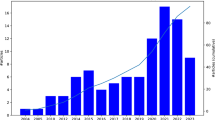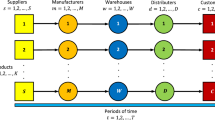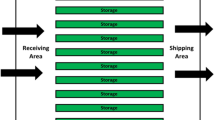Abstract
Leveraging product differentiation and mass production efficiency in mass customization basically entails a configure-to-order paradigm. In the engineer-to-order (ETO) business, however, companies build unique products in response to ‘foreseeable’ customer specifications. The key challenge of ETO mass customization lies in the complexity of accommodating future design changes when customers are involved in customizing design specifications. This paper proposes a two-stage, bi-level stochastic programming framework to tackle ETO mass customization. At the first stage, product platform configuration is integrated with production reconfiguration, which is formulated as a shortest path problem with resource constraints (SPPRC) to optimize production delays within the capabilities of the process platform. Benders’ decomposition algorithm is applied to solve this optimal configuration problem owing to its high computational efficiency. The second stage scrutinizes the optimal configuration resulting from the first stage for scaling optimization of design parameters (DPs) for each module. All DPs are differentiated by standard or customizable DPs. A bi-level stochastic program is implemented to leverage conflicting goals between the producer (leader) and consumer (follower) surpluses. As a result, ETO customization design is anchored with optimal values of standard DPs and optimal value ranges of customizable DPs. A case study of ship engine and power generator ETO design is presented, demonstrating the feasibility and potential of the ETO mass customization framework.
Similar content being viewed by others
References
Aldonondo M., Vareilles E. (2008) Configuration for mass customization: How to extend product configuration towards requirements and process configuration. Journal of Intelligent Manufacturing 19(1): 521–535
Akundi, S., Simpson, T. W., & Reed, P. M. (2005). Multi-objective design optimization for product platform and product family design using genetic algorithms. ASME design engineering technical conferences, DETC2005/DAC-84905, Long Beach, CA.
Briere-Cote A., Rivest L., Desrochers A. (2010) Adaptive generic product structure modeling for design reuse in engineer-to-order products. Computers in Industry 61: 53–65
Desrosiers J., Soumis F., Desrochers M. (1984) Routing with time windows by column generation. Networks 14: 545–565
Faneyte D. B. C., Spieksma F. C. R., Woeginger G. J. (2002) A branch-and-price algorithm for a hierarchical crew scheduling problem. Naval Research Logistics (NRL) 49(8): 743–759
Fujita, K., Sakaguchi, H., & Akagi, S. (1999). Product variety deployment and its optimization under modular architecture and module communalization. ASME design engineering technical conferences DETC99/DFM-8923, Las Vegas, NV.
Gumus Z. H., Floudas C. A. (2001) Global optimization of nonlinear bi-level programming problems. Journal of Global Optimization 20: 1–31
Gunasekaran A. (1998) Agile manufacturing: Enablers and an implementation framework. International Journal of Production Research 36(5): 1223–1247
Jiao J. R., Tseng M., Ma Q., Zhou Y. (2000) Generic bill-of-materials-and-operations for high-variety production management. Concurrent Engineering: Research and Applications 8(4): 297–321
Jiao J., Simpson T. W., Siddique Z. (2007) Product family design and platform-based product development: A state-of-the-art review. Journal of Intelligent Manufacturing 18(1): 5–29
Jiao J. R., Zhang L. L., Pokharel S. (2007) Process platform planning for variety coordination from design to production in mass customization manufacturing. IEEE Transactions on Engineering Management 54(1): 112–129
Khalaf R. E. H., Agard B., Penz B. (2010) An experimental study for the selection of modules and facilities in a mass customization context. Journal of Intelligent Manufacturing 2(1): 703–716
Khrisnapillai R., Zeid A. (2006) Mapping product design specification for mass customization. Journal of Intelligent Manufacturing 17(1): 29–43
Knight M. P., Kim S. H. (1991) A knowledge system for integrated product design. Journal of Intelligent Manufacturing 2(1): 17–25
Koren Y., Heisel U., Jovane F., Moriwaki T., Pritschow G., Ulsoy G., Van Brussel H. (1999) Reconfigurable manufacturing systems. Annals of CIRP 48(2): 527–540
Mehrabi M. B., Ulsoy A. B., Koren Y. (2000) Reconfigurable manufacturing systems: Key to future manufacturing. Journal of Intelligent Manufacturing 11(1): 403–419
Mercier A., Cordeau J. F., Soumis F. (2005) A computational study of Benders’ decomposition for the integrated aircraft routing and crew scheduling problem. Computers and Operations Research 32: 1451–1476
Pine B. J. (1993) Mass customization: The new frontier in business competition. Harvard Business School Press, Boston
Saharidis G. K. D., Minoux M., Ierapetritou M. G. (2010) Accelerating Bender’s method using covering cut bundle generation. International Transactions in Operational Research 17: 221
Simpson T. W., Meier J. R. A., Mistree F. (2001) Product platform design: Research and application. Research in Engineering Design 13: 2–22
Simpson T. W. (2004) Product platform design and customization: Status and promise. AIEDAM 18(1): 3–20
Stojkovic M., Soumis F. (2001) An optimization model for the simultaneous operational flight and pilot scheduling problem. Management Science 47(9): 1290–1305
Tatsiopoulos I. P. (1996) On the unification of bills of materials and routings. Computers in Industry 31: 293–304
Ulrich K. (1995) The role of product architecture in the manufacturing firm. Research Policy 24(3): 419–440
Author information
Authors and Affiliations
Corresponding author
Rights and permissions
About this article
Cite this article
Kristianto, Y., Helo, P. & Jiao, R.J. Mass customization design of engineer-to-order products using Benders’ decomposition and bi-level stochastic programming. J Intell Manuf 24, 961–975 (2013). https://doi.org/10.1007/s10845-012-0692-z
Received:
Accepted:
Published:
Issue Date:
DOI: https://doi.org/10.1007/s10845-012-0692-z




